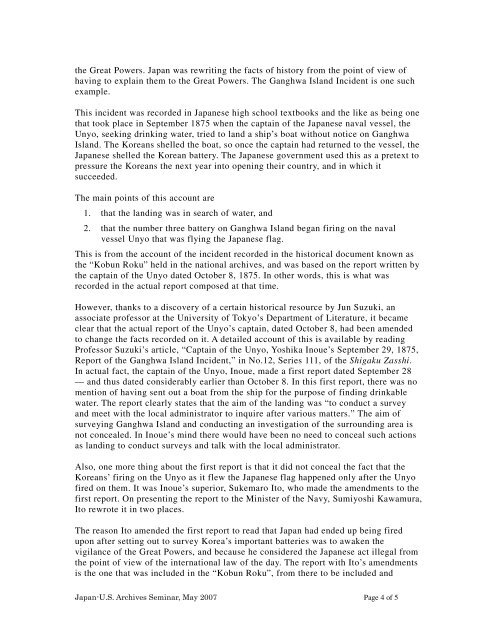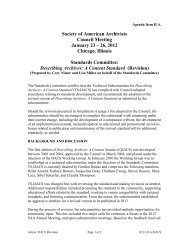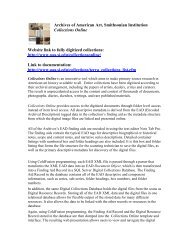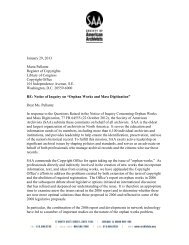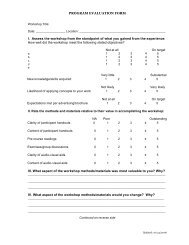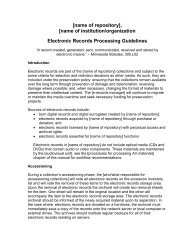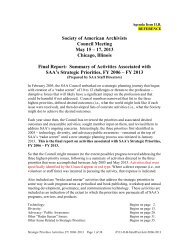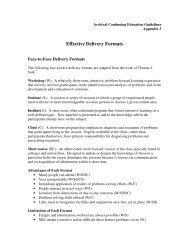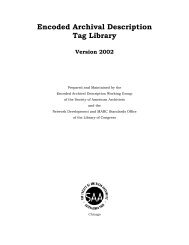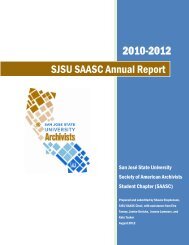The Use and Misuse of History in Modern Japanese History
The Use and Misuse of History in Modern Japanese History
The Use and Misuse of History in Modern Japanese History
You also want an ePaper? Increase the reach of your titles
YUMPU automatically turns print PDFs into web optimized ePapers that Google loves.
the Great Powers. Japan was rewrit<strong>in</strong>g the facts <strong>of</strong> history from the po<strong>in</strong>t <strong>of</strong> view <strong>of</strong><br />
hav<strong>in</strong>g to expla<strong>in</strong> them to the Great Powers. <strong>The</strong> Ganghwa Isl<strong>and</strong> Incident is one such<br />
example.<br />
This <strong>in</strong>cident was recorded <strong>in</strong> <strong>Japanese</strong> high school textbooks <strong>and</strong> the like as be<strong>in</strong>g one<br />
that took place <strong>in</strong> September 1875 when the capta<strong>in</strong> <strong>of</strong> the <strong>Japanese</strong> naval vessel, the<br />
Unyo, seek<strong>in</strong>g dr<strong>in</strong>k<strong>in</strong>g water, tried to l<strong>and</strong> a ship’s boat without notice on Ganghwa<br />
Isl<strong>and</strong>. <strong>The</strong> Koreans shelled the boat, so once the capta<strong>in</strong> had returned to the vessel, the<br />
<strong>Japanese</strong> shelled the Korean battery. <strong>The</strong> <strong>Japanese</strong> government used this as a pretext to<br />
pressure the Koreans the next year <strong>in</strong>to open<strong>in</strong>g their country, <strong>and</strong> <strong>in</strong> which it<br />
succeeded.<br />
<strong>The</strong> ma<strong>in</strong> po<strong>in</strong>ts <strong>of</strong> this account are<br />
1. that the l<strong>and</strong><strong>in</strong>g was <strong>in</strong> search <strong>of</strong> water, <strong>and</strong><br />
2. that the number three battery on Ganghwa Isl<strong>and</strong> began fir<strong>in</strong>g on the naval<br />
vessel Unyo that was fly<strong>in</strong>g the <strong>Japanese</strong> flag.<br />
This is from the account <strong>of</strong> the <strong>in</strong>cident recorded <strong>in</strong> the historical document known as<br />
the “Kobun Roku” held <strong>in</strong> the national archives, <strong>and</strong> was based on the report written by<br />
the capta<strong>in</strong> <strong>of</strong> the Unyo dated October 8, 1875. In other words, this is what was<br />
recorded <strong>in</strong> the actual report composed at that time.<br />
However, thanks to a discovery <strong>of</strong> a certa<strong>in</strong> historical resource by Jun Suzuki, an<br />
associate pr<strong>of</strong>essor at the University <strong>of</strong> Tokyo’s Department <strong>of</strong> Literature, it became<br />
clear that the actual report <strong>of</strong> the Unyo’s capta<strong>in</strong>, dated October 8, had been amended<br />
to change the facts recorded on it. A detailed account <strong>of</strong> this is available by read<strong>in</strong>g<br />
Pr<strong>of</strong>essor Suzuki’s article, “Capta<strong>in</strong> <strong>of</strong> the Unyo, Yoshika Inoue’s September 29, 1875,<br />
Report <strong>of</strong> the Ganghwa Isl<strong>and</strong> Incident,” <strong>in</strong> No.12, Series 111, <strong>of</strong> the Shigaku Zasshi.<br />
In actual fact, the capta<strong>in</strong> <strong>of</strong> the Unyo, Inoue, made a first report dated September 28<br />
— <strong>and</strong> thus dated considerably earlier than October 8. In this first report, there was no<br />
mention <strong>of</strong> hav<strong>in</strong>g sent out a boat from the ship for the purpose <strong>of</strong> f<strong>in</strong>d<strong>in</strong>g dr<strong>in</strong>kable<br />
water. <strong>The</strong> report clearly states that the aim <strong>of</strong> the l<strong>and</strong><strong>in</strong>g was “to conduct a survey<br />
<strong>and</strong> meet with the local adm<strong>in</strong>istrator to <strong>in</strong>quire after various matters.” <strong>The</strong> aim <strong>of</strong><br />
survey<strong>in</strong>g Ganghwa Isl<strong>and</strong> <strong>and</strong> conduct<strong>in</strong>g an <strong>in</strong>vestigation <strong>of</strong> the surround<strong>in</strong>g area is<br />
not concealed. In Inoue’s m<strong>in</strong>d there would have been no need to conceal such actions<br />
as l<strong>and</strong><strong>in</strong>g to conduct surveys <strong>and</strong> talk with the local adm<strong>in</strong>istrator.<br />
Also, one more th<strong>in</strong>g about the first report is that it did not conceal the fact that the<br />
Koreans’ fir<strong>in</strong>g on the Unyo as it flew the <strong>Japanese</strong> flag happened only after the Unyo<br />
fired on them. It was Inoue’s superior, Sukemaro Ito, who made the amendments to the<br />
first report. On present<strong>in</strong>g the report to the M<strong>in</strong>ister <strong>of</strong> the Navy, Sumiyoshi Kawamura,<br />
Ito rewrote it <strong>in</strong> two places.<br />
<strong>The</strong> reason Ito amended the first report to read that Japan had ended up be<strong>in</strong>g fired<br />
upon after sett<strong>in</strong>g out to survey Korea’s important batteries was to awaken the<br />
vigilance <strong>of</strong> the Great Powers, <strong>and</strong> because he considered the <strong>Japanese</strong> act illegal from<br />
the po<strong>in</strong>t <strong>of</strong> view <strong>of</strong> the <strong>in</strong>ternational law <strong>of</strong> the day. <strong>The</strong> report with Ito’s amendments<br />
is the one that was <strong>in</strong>cluded <strong>in</strong> the “Kobun Roku”, from there to be <strong>in</strong>cluded <strong>and</strong><br />
Japan-U.S. Archives Sem<strong>in</strong>ar, May 2007 Page 4 <strong>of</strong> 5


